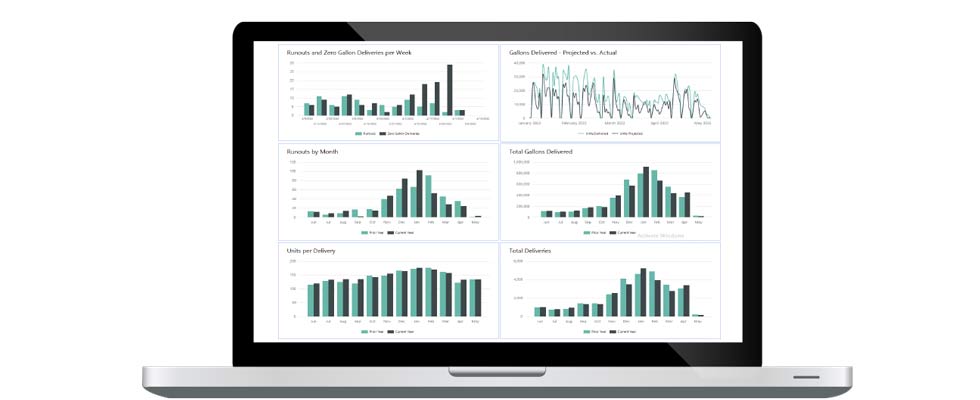
Summer means different things to different propane companies. It could be the beginning of a slow period as the heating season comes to a close. It can also mark a heavy switch to recreational use and, in some areas, increased business due to summer vacation rentals.
But in most cases, summer changes mean deliveries that are harder to predict and a slower period with time that can be used for reflection. Thankfully, technology helps businesses successfully manage the change, and it presents opportunities for marketers to set themselves up for success during busier times. This summer shift itself is nothing new, but propane business summer projects have gained more focus than ever since the pandemic. During the summer of 2020, one of the most common comments from propane retailers was, “We thought things would slow down this summer, but we are busier than ever!” COVID-19 was a disruption, to say the least, but the industry was determined to meet the challenge. That means improving business processes became a year-round effort.
Summer Challenge: Less Predictable Deliveries
The most obvious change summer brings is the shift from primarily heat usage to cooking, cleaning and recreational usage. This could be restated as a change from predictable to less predictable usage, and it is a challenge to efficiency. The goal is to deliver more gallons while driving less miles, but unpredictable deliveries make this difficult. There are two main ways that technology can help close this potential summer efficiency gap: maintenance of accurate delivery predictions and communication with customers. Technology can help with both issues.
Back-office software helps predict customer usage, even in the summertime. However, recreational usage can be difficult to predict, and non-heat household usage can be just as difficult in a period when many people leave for vacations. Delivery scheduling systems will continue to predict usage based on that customer’s non-heat parameters and will call attention to delivery exceptions, such as deliveries outside the ideal range, zero-gallon deliveries and runouts. However back-office software can also automatically communicate with tank monitors.
To deal with unpredictability, retailers can choose to install them to guarantee no runouts, and customers are often willing to pay for the service to avoid any interruption. As a backup, back-office software not only can collect tank readings and pull tickets based on the readings, but the next delivery date can continue to be predicted so that if a tank monitor fails, the system will still pull a ticket based on the usage pattern.
Of course, tank monitors cost money, and not every account will want them or have usage that justifies the associated cost to a propane retailer. For that, technology can help in another way: by facilitating emails or texts to the customer to help make delivery timing spot on. For example, all customers due for delivery next week can be emailed to ask them to read their tank gauge. Next delivery date can be adjusted based on the responses. The same thing can be done when a delivery truck will be in a specific area. Retailers can email customers in the area, asking them to read their tank gauge. People don’t want to run out of fuel, so the incentive is there for them to help raise delivery efficiency.
For accounts that have run out due to unpredictable summer usage, email all of them in an instant and recommend a tank monitor. Or email everyone who uses propane to heat a pool or to cook on their built-in propane grill. The proactive communication possibilities are endless. Modern back-office systems can have all these communication tools set up and ready to use as part of the normal summer process.
Service Scheduling
What about the service department? Summer is the time for scheduling cleanings. Back-office scheduling software can help make this easier and more organized. Use it to schedule cleanings around other heating, ventilation and air conditioning work, and let it suggest the most efficient schedule based on zones, tech proficiency and job duration.
Service was once accepted as an unprofitable necessity, but today technology can change that with efficient scheduling and dispatching and a clear view into profitability with analysis reporting.
Automatic Analytics Give a Clear Picture
Perhaps the easiest tech to implement over the summer is business intelligence reporting, and it can help at any time of the year. Implementation does not require any process changes, but instead will give a more accurate view of operations to aid in decisions. A dashboard of the most important key performance indicators (KPIs) gives a real-time window to management and can be automatically emailed on a preset schedule. And that is not the only thing that can be automatically emailed; any exceptions to the norm — like runouts — can be alerts that are emailed automatically. The unpredictability of summer usage can be mitigated with business intelligence (BI) reporting that allows management to identify and correct issues as quickly and efficiently as possible.
A Chance to Use Tech to Improve
These are just some of the ways technology processes may change to address the summer landscape, but summer is also a chance to prepare for the next busy winter season. It’s a time to take stock and improve — and technology can help.
Take Delivery Efficiency to the Next Level
As stated earlier, more efficient deliveries are paramount. Throughout the year, back-office software helps improve delivery efficiency, but now is the time to take an even closer look. Are tanks in the field sized correctly, or can some be swapped to make fewer, larger drops? Every drop saved means more profit, and a back-office solution can point out these opportunities. Are routes efficient? Simply stated, the goal is to drive less miles and deliver more gallons. Do delivery zones need adjusting? Maybe they were put in place years ago and subsequent acquisitions have complicated them even more. It could be time to rezone, and back-office reporting can help with decisions. A summer slowdown may be the perfect time for a project like this.
Think about what additional tech can help with efficiency in busy times. In the same way that tank monitors can help with customers who have unpredictable summer usage, monitors can help with the most valuable customers. This is a quick and easy tech addition that can improve efficiency and profitability and keep valuable customers happy.
What about adding mobile delivery computing that completely interfaces with back-office software? With efficient communication between drivers and dispatchers, turn-by-turn directions, greater accuracy, information at drivers’ fingertips and faster time to payment, it is a guaranteed path to greater efficiency. It also allows for a better customer experience with real-time text and email communication, real-time information for customer service representatives (CSRs), and real-time information on a web portal.
Solidify Service as a Profit Center
Efficient scheduling, as mentioned earlier, is an important piece of a profitable service department, but a powerful dispatch monitor and mobile technology in your tech’s hands can advance your department to the next level. Jobs can be completed faster with full account history in the tech’s hands. The streamlined communication between the dispatcher and the techs saves a tremendous amount of time, and the billing accuracy and decreased time to payment leads to greater profitability and happier customers. Back-office software can bring service opportunities to the surface. Profitability analysis and a KPI dashboard with drill-down capability can help home in on unprofitable work so it can be addressed. BI reporting can easily turn your data and activities into actionable information.
Exceed Customer Communication Expectations
With every increase in technology usage comes an increased ability to communicate well with customers, and that is an important expectation today. Adding mobile technology for drivers and techs enables automatic and expedient communication with customers. Messages like “your tech will arrive in 30 minutes” or “your delivery was just made” help improve the customer experience, and in busy times, this level of communication cannot happen without automation enabled by technology. It is a differentiator that will please customers and attract new ones.
Now is the time to put some thought into customer communications and set up automatic texts and emails so they are ready in busier periods. Over the summer, offer special incentives to customers to encourage them to update their email and cell phone numbers. Have CSRs, drivers and techs ask for updates as well. Then, set up standard communications to use now and throughout the year, including notifications of deliveries, service and payments. Also, plan some email programs to gain customers, like incentives to refer a friend or incentives to change to an automatic delivery. There are endless possibilities.
Let Customers Do It Themselves
Self-service options are an expectation today. When tied to back-office software, a portal has the ability to save office personnel a tremendous amount of time, and it enables growth. Opening a new account, requesting a delivery or service, getting on a budget program and making a payment can all be done without CSR involvement. It cuts down on phone calls while increasing the level of customer support.
Summertime brings changes to propane retailer operations, but back-office software is there to help. From different types of usage to improvement of processes overall, the real message here is that there is always more that can be done with technology. With the analysis tools tech brings, companies can pinpoint areas that need attention and then use those tools to better address them. Start exploring today.


